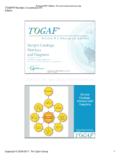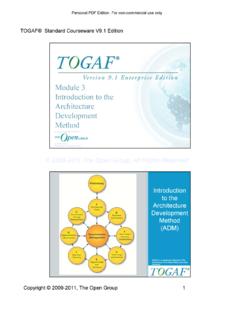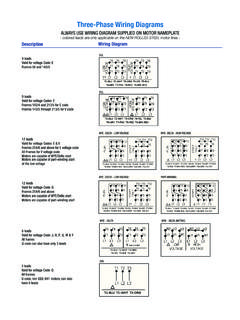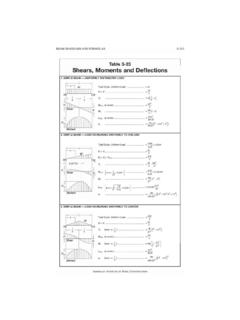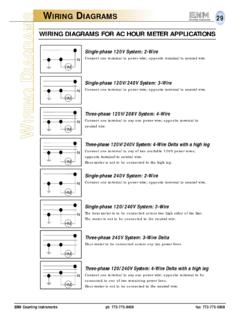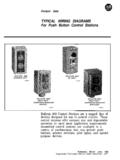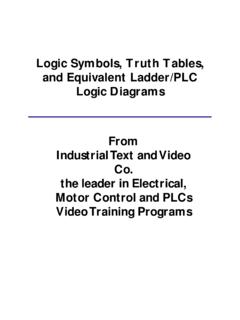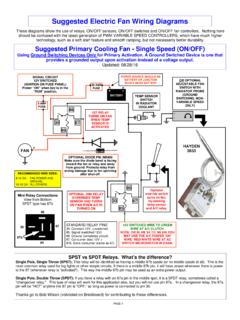Transcription of Sample Catalogs, Matrices and Diagrams - The Open Group
1 TOGAF Standard Courseware V9 EditionCopyright 2009-2011, The Open Group1 2009-2011 The Open Group , All Rights ReservedSlide 1 Sample Catalogs, Matrices and : 7 April 2011 Download the bundle from Open Group gratefully acknowledges the contributionsfrom SAP and CapgeminiV9 Edition Copyright 2009-2011 All rights reservedPublished by The Open Group , 2011 2009-2011 The Open Group , All Rights ReservedSlide 2 Sample Catalogs, Matrices and DiagramsTOGAF is a registered trademark of The Open Group in the United States and other countriesPersonal PDF Edition. For non-commercial use only 2009-2011 The Open Group , All Rights ReservedTOGAF Standard Courseware V9 EditionCopyright 2009-2011, The Open Group2 2009-2011 The Open Group , All Rights ReservedSlide 3 ObjectivesThe objectives of this presentation are to illustrate: TOGAF 9 Catalogs, Matrices and Diagrams What they consist of Examples How they can be usedThe examples shown are illustrative.
2 The exact format of the catalogs, Matrices and Diagrams will depend on the tools used and adaptations to TOGAF for the specific EA. 2009-2011 The Open Group , All Rights ReservedSlide 4 TOGAF 9 Catalogs, Matrices and DiagramsPhase A, Architecture Vision Stakeholder Map matrix Value Chain diagram Solution Concept diagramRequirements Management Requirements catalogPhase C, Application Architecture Application Portfolio catalog Interface catalog System/Organization matrix Role/System matrix System/Function matrix Application Interaction matrix Application Communication diagram Application and User Location diagram System Use-Case diagram Enterprise Manageability diagram Process/System Realization diagram Software Engineering diagram Application Migration diagram Software Distribution diagramPhase E.
3 Opportunities & Solutions Project Context diagram Benefits diagramPhase C, Data Architecture Data Entity/Data Component catalog Data Entity/Business Function matrix System/Data matrix Class diagram Data Dissemination diagram Data Security diagram Class Hierarchy diagram Data Migration diagram Data Lifecycle diagramPhase D, Technology Architecture Technology Standards catalog Technology Portfolio catalog System/Technology matrix Environments and Locations diagram Platform Decomposition diagram Processing diagram Networked Computing/Hardware diagram Communications Engineering diagramPhase B, Business Architecture Organization/Actor catalog Driver/Goal/Objective catalog Role catalog Business Service/Function catalog Location catalog Process/Event/Control/Product catalog Contract/Measure catalog Business Interaction matrix Actor/Role matrix Business Footprint diagram Business Service/Information diagram Functional Decomposition diagram Product Lifecycle diagram Goal/Objective/Service diagram Business Use-Case diagram Organization Decomposition diagram Process Flow diagram Event diagramPreliminary Phase Principles catalogPersonal PDF Edition.
4 For non-commercial use only 2009-2011 The Open Group , All Rights ReservedTOGAF Standard Courseware V9 EditionCopyright 2009-2011, The Open Group3 2009-2011 The Open Group , All Rights ReservedSlide 5 Preliminary PhaseCatalogs, Matrices and DiagramsCatalogs Principles CatalogMatricesDiagramsP 2009-2011 The Open Group , All Rights ReservedSlide 6 CatalogsPThe Principles catalog captures principles of the business and architecture principles that describe what a "good" solution or architecture should look like. Principles are used to evaluate and agree an outcome for architecture decision points. Principles are also used as a tool to assist in architectural governance of change Principles catalog contains the following metamodel entities:* PrinciplePrinciplesCatalogPurposeCatalog Personal PDF Edition.
5 For non-commercial use only 2009-2011 The Open Group , All Rights ReservedTOGAF Standard Courseware V9 EditionCopyright 2009-2011, The Open Group4 2009-2011 The Open Group , All Rights ReservedSlide 7 Architecture Vision Catalogs, Matrices and DiagramsCatalogsMatrices Stakeholder Map MatrixDiagrams Value Chain Diagram Solution Concept DiagramA 2009-2011 The Open Group , All Rights ReservedSlide 8 Example Stakeholder Map MatrixRoadmapsBusiness FootprintApplication CommunicationFunctional DecompositionKeep SatisfiedThis stakeholder Group is interested in prioritizing, funding, and aligning change activity. An understanding of project content and technical dependencies adds a further dimension of richness to portfolio management and decision Management OfficeOrganization ChartOrganization/Actor/ LocationKeep InformedKey features of the enterprise architecture are roles and Actors that support the functions, applications, and technology of the organization.
6 HR are important stakeholders in ensuring that the correct roles and actors are FootprintGoal/Objective/Service ModelOrganization ChartKeep SatisfiedThis stakeholder Group is interested in the high-level drivers, goals and objectives of the organization, and how these are translated into an effective process and IT architecture to advance the businessCxORelevant ArtifactsClassInvolvementStakeholderAPer sonal PDF Edition. For non-commercial use only 2009-2011 The Open Group , All Rights ReservedTOGAF Standard Courseware V9 EditionCopyright 2009-2011, The Open Group5 2009-2011 The Open Group , All Rights ReservedSlide 9 Example Value Chain DiagramSource: 2009-2011 The Open Group , All Rights ReservedSlide 10 Value Chain DiagramProduct & OfferFulfilmentSalesPaymentsServicingAPe rsonal PDF Edition.
7 For non-commercial use only 2009-2011 The Open Group , All Rights ReservedTOGAF Standard Courseware V9 EditionCopyright 2009-2011, The Open Group6 2009-2011 The Open Group , All Rights ReservedSlide 11 Value Chain DiagramA 2009-2011 The Open Group , All Rights ReservedSlide 12 Example Solution Concept Diagram A high-level representation of the solution envisaged A pencil sketchof the expected solution at the outset of the engagementAMembershipConference AttendanceCertificationPublicationCustom ersReliable, 24x7, self-service infrastructureInterest, consideration, join, re-newPersonal PDF Edition. For non-commercial use only 2009-2011 The Open Group , All Rights ReservedTOGAF Standard Courseware V9 EditionCopyright 2009-2011, The Open Group7 2009-2011 The Open Group , All Rights ReservedSlide 13 Solution Concept DiagramA 2009-2011 The Open Group , All Rights ReservedSlide 14 Solution Concept Diagram Today s use of channels Tomorrow s use of channels SERVICE TEAM RM CALL CENTER SELF SERVICE INTERNET PORTAL SERVICE TEAM RM CALL CENTER SELF SERVICE INTERNET PORTAL From Call Centre to Online From Service Team to Online From RMto Online From Service Team to CC From RM to CC From RMto ST Low Value Tasks High Value Tasks APersonal PDF Edition.
8 For non-commercial use only 2009-2011 The Open Group , All Rights ReservedTOGAF Standard Courseware V9 EditionCopyright 2009-2011, The Open Group8 2009-2011 The Open Group , All Rights ReservedSlide 15 Business Architecture Catalogs, Matrices and DiagramsCatalogs Organization/Actor catalog Driver/Goal/Objective catalog Role catalog Business Service/Function catalog Location catalog Process/Event/Control/Product catalog Contract/Measure catalogMatrices Business Interaction matrix Actor/Role matrixDiagrams Business Footprint diagram Business Service/Information diagram Functional Decomposition diagram Product Lifecycle diagram Goal/Objective/Service diagram Business Use-Case diagram Organization Decomposition diagram Process Flow diagram Event diagramB 2009-2011 The Open Group .
9 All Rights ReservedSlide 16 CatalogsThe purpose of the Role catalog is to provide a listing of all authorization levels or zones within an enterprise. Frequently, application security or behavior is defined against locally understood concepts of authorization that create complex and unexpected consequences when combined on the user contains the following metamodel entities: RoleRole CatalogA cross-organizational reference of how an organization meets its drivers in practical terms through goals, objectives, and (optionally) contains the following metamodel entities: Organization Unit, Driver, Goal, Objective, Measure (may optionally be included) Driver/Goal/ ObjectiveCatalogA definitive listing of all participants that interact with IT, including users and owners of IT contains the following metamodel entities.
10 Organization Unit, Actor Location (may be included in this catalog if an independent Location catalog is not maintained)Organization/ ActorCatalogPurposeCatalogBPersonal PDF Edition. For non-commercial use only 2009-2011 The Open Group , All Rights ReservedTOGAF Standard Courseware V9 EditionCopyright 2009-2011, The Open Group9 2009-2011 The Open Group , All Rights ReservedSlide 17 CatalogsThe Process/Event/Control/Product catalog provides a hierarchy of processes, events that trigger processes, outputs from processes, and controls applied to the execution of processes. This catalog provides a supplement to any Process Flow Diagrams that are created and allows an enterprise to filter, report, and query across organizations and processes to identify scope, commonality, or contains the following metamodel entities: Process, Event, Control, ProductProcess/ Event/ Control/ Product CatalogA listing of all locations where an enterprise carries out business operations or houses architecturally relevant assets, such as data centers or end-user computing contains the following metamodel entities.
